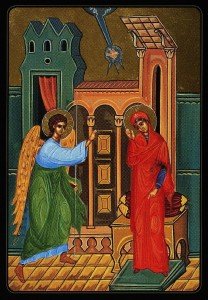 I have been considering the history of the major feasts of our Church and the factors that have caused them to be established. In more recent weeks I have been sharing information about the Marian feasts of our Church.
I have been considering the history of the major feasts of our Church and the factors that have caused them to be established. In more recent weeks I have been sharing information about the Marian feasts of our Church.
The Feast of the Annunciation. Which celebrates the announcement that Mary was to become the Mother of Christ, is the next to be considered. Unfortunately the feast’s origin is completely obscure, but we do know that it had become widespread by the seventh century. As this was only a short time after Emperor Maurice’s decree concerning the Dormition, the rationale for adopting the Annunciation was very much the same. In 612 the Nestorian Church of Persia formally rejected the term Theotokos. The military situation had intensified by this time as well. The schism between Monophysitism and the True Faith, weakened the Empire in its struggle with Persia and therefore prompted a concerted government attempt to reconcile the Monophysites. The time was ripe for the institution of this feast, which, according to John of Damascus in his work The Orthodox Faith, marks the reception of the Divine Word. As an Orthodox feast, then, the Annunciation celebrates the actual moment of Mary’s becoming the Theotokos.
And yet Dix, one of the prominent authors who has written about the establishment of our feasts, would have us believe that the Annunciation is really a feast of Christ. While this may be the case in purely theological terms, history suggests that the feast had a different meaning for the people of the time. Among its oldest names are sanctae Virginis festum and festivitas gloriosae Matris. These would suggest that the contemporary mind focused on the Virgin’s role in this feast, rather than on Christ’s. Indeed, since the fifth century the Virgin loomed ever larger in popular Monophysite devotion, to the point of almost rivaling Christ Himself.
There seems to have been a calculated escalation from the ambiguous Presentation to the theologically less important but wholly Marian Dormition to the Annunciation which glorifies Mary’s all important role in the history of mankind’s salvation. To what extend these feasts also dealt with secondary theological issues is not important here. What is important is that the Marian Feasts, like those dealing directly with the nature of Christ, did not arise from popular devotion but were devised in opposition to heterodox doctrine which threatened to divide the Empire. They are the logical successors to the earlier feasts.
